Nothing quite represents ancient Egyptian culture like megalithic structures. It’s time to delve into the world of pharaohs and shed some light on the fascinating wonders of Egyptian engineering that have captivated humanity for millennia.
The Pyramids of Giza are undoubtedly the most visited place in Egypt. This UNESCO World Heritage Site of ancient structures has survived for nearly 5,000 years! Each year, almost 14 million tourists from around the globe flock to this site to witness one of the Seven Wonders of the Ancient World and see for themselves if the two largest pyramid tombs built in ancient Egypt are truly as impressive as they seem.
The Beginnings of Egyptian Pyramids
Before the first pyramids appeared on Egyptian soil, burials took place in structures known as mastabas, tombs shaped like truncated pyramids with a rectangular base. The legendary sage Imhotep, who was hired as the architect for the tomb of King Djoser, decided to take this a step further. He instructed that additional structures of the same shape, each slightly smaller than the previous one, be placed atop the large mastaba.
This is how Egypt’s first pyramid, the Step Pyramid, was created, and it can still be seen today in Saqqara, located just under 30 km from Giza. However, the bar was significantly raised by the builders of the subsequent true pyramids, which left an even deeper mark on the history of the world.
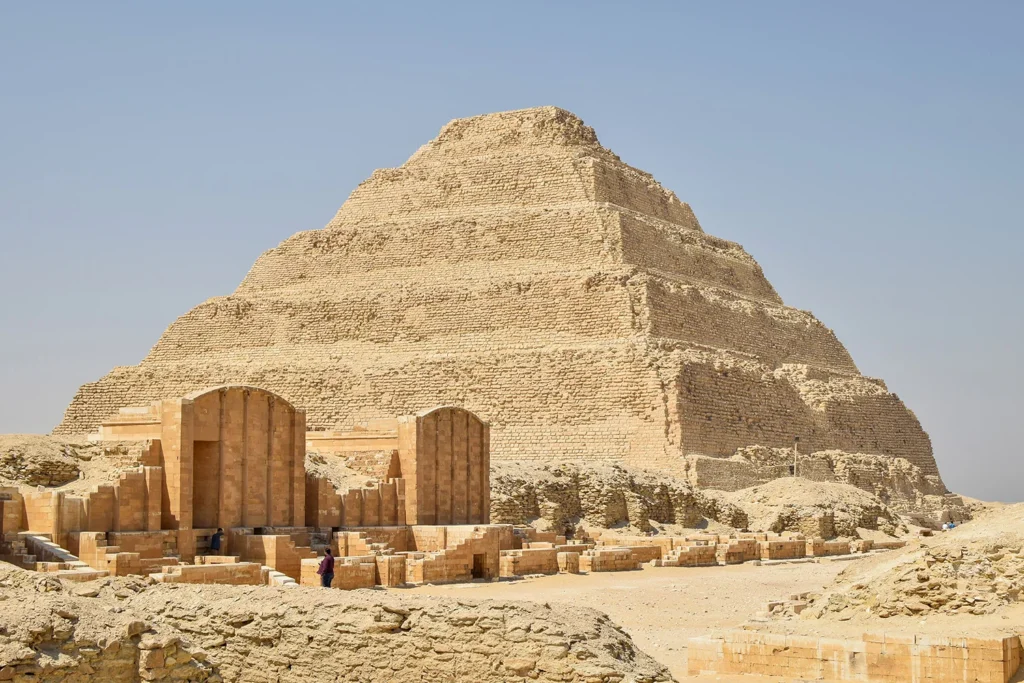
How were the Great Pyramids of Giza built?
Alright, but how exactly were these architectural marvels constructed? The process typically began with an important ritual involving the stretching of a cord in alignment with the stars. This method helped establish the building’s axis in relation to the cardinal directions. Once right angles were set to determine the positions of the walls, the placement of limestone blocks could begin.
It sounds relatively straightforward, but moving stones weighing an average of about 2.5 tons was no easy feat, especially since only human and animal power was used for transportation. Specially designed sledges likely aided the workers, and ramps were used to haul the blocks to higher levels, often moistened to reduce friction and facilitate movement.
FUN FACT: When thinking of pyramid construction, our imagination often conjures up the widely perpetuated image from popular culture: thousands of malnourished slaves, whipped as they struggled to drag or push heavy stones. However, it has been proven that this image is largely inaccurate. The pyramids were primarily built by skilled Egyptian laborers, and those involved in transportation were not slaves, but paid workers. The king took care of their health, provided them with quality meals, and allowed regular breaks, all to ensure that they remained strong and completed the construction of the royal tomb as swiftly as possible.
The Giza Plateau
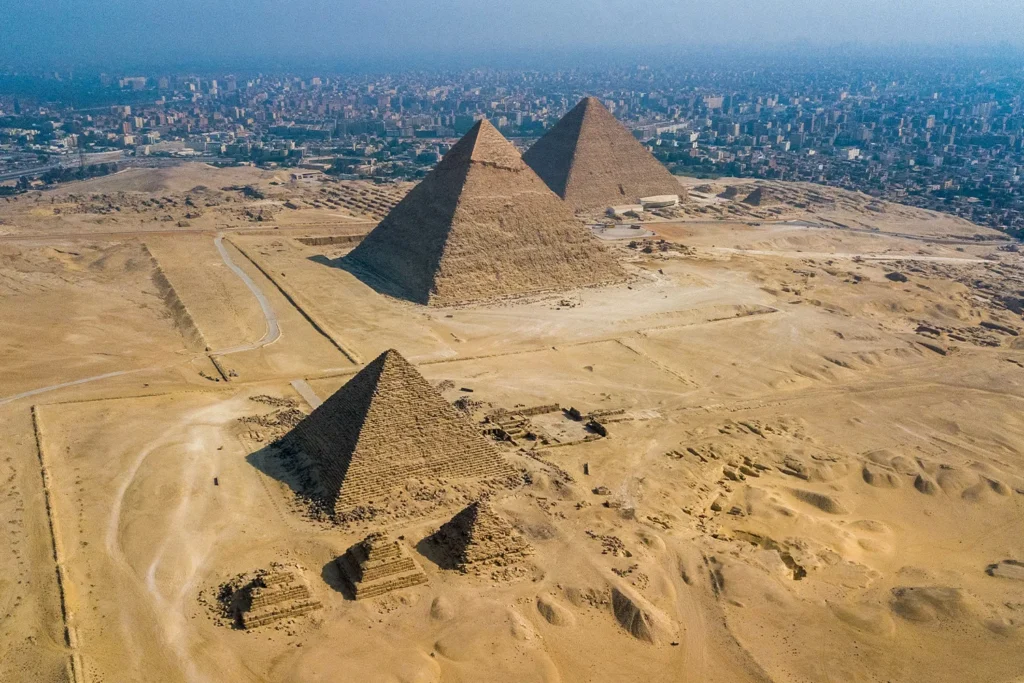
The Giza Plateau is dominated by the three great pyramids, but in reality, they are surrounded by many other ancient structures. Each pyramid served as the central point of a larger funerary complex. Around them were often smaller “queen’s pyramids,” satellite pyramids (serving as secondary symbolic tombs), and temples dedicated to maintaining the king’s cult, honoring his divine aspect, and making offerings to ensure his peaceful and luxurious afterlife.
The Pyramid of Khufu
Some of you may know it as the Pyramid of Cheops or the Great Pyramid, as several names are used interchangeably for this marvel of ancient engineering. It was built around 2560 BCE during the Egyptian Old Kingdom. It’s not only the oldest of the Seven Wonders of the Ancient World but also the only one that still stands to this day.
Time has reduced its height slightly, and today the monument stands at just over 138 meters, but originally, the pyramid measured 146.5 meters, making it the tallest man-made structure in the world for about 3,800 years. The exact methods of its construction are still not fully known, but it’s clear that it was no easy feat, as estimates suggest that it took between 10 and 20 years to complete.
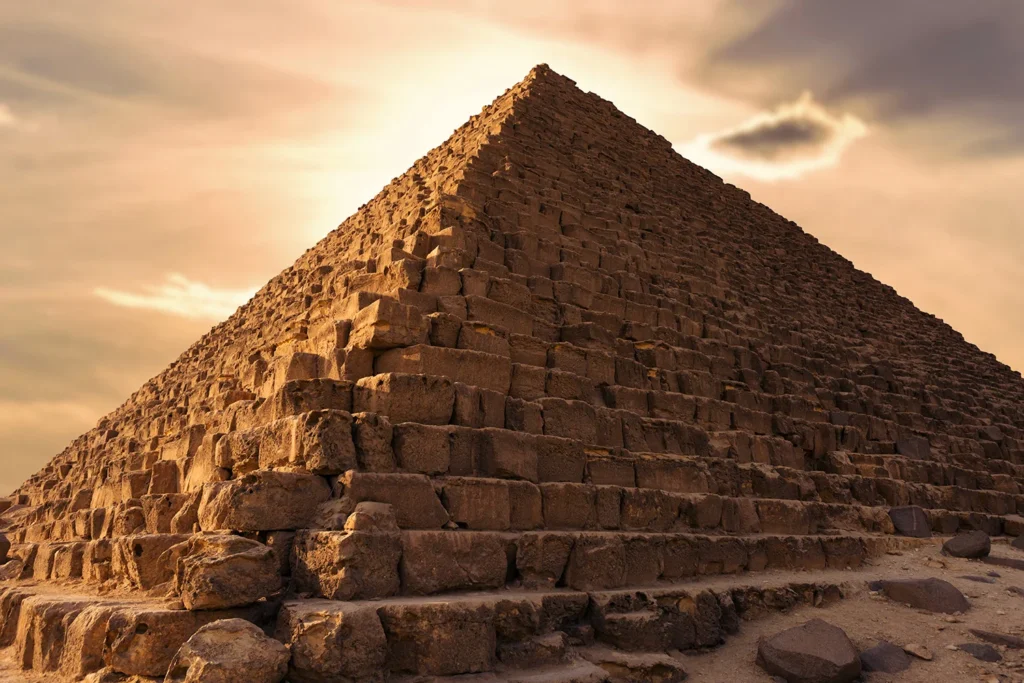
The Great Pyramid of Khufu was constructed using local limestone. Its form has remained virtually intact over the centuries, but it’s worth noting that the ancient Egyptians did not see it exactly as we do today. The exterior was originally covered with a high-quality casing of polished limestone, which would have glistened in the sun, resembling gold. However, over the millennia, this decorative layer was stripped away, leaving the bare limestone blocks we see today.
You’ve likely wondered how the interior of the Great Pyramid is organized. It’s time to demystify it. The pyramid contains three chambers: one carved into the bedrock, and two others located higher up within the stone structure itself. Visitors can only access the interior through the Grand Gallery—a magnificently soaring passage, considered a remarkable achievement of ancient engineering. Its walls, towering over 2 meters high and made of polished limestone, lead to the King’s Chamber, one of the upper rooms, where the sarcophagus once holding Khufu’s mummy still remains.
FUN FACT: The King’s Chamber is the only part of the Great Pyramid accessible to the public, but it’s far from the only space discovered. Many other chambers, corridors, and vestibules have been found within the structure, though they are currently accessible only to archaeologists. Most fascinatingly, many scientists believe the pyramid still holds numerous unexplored sections and unsolved mysteries waiting to be uncovered.
Pyramid of Khafre
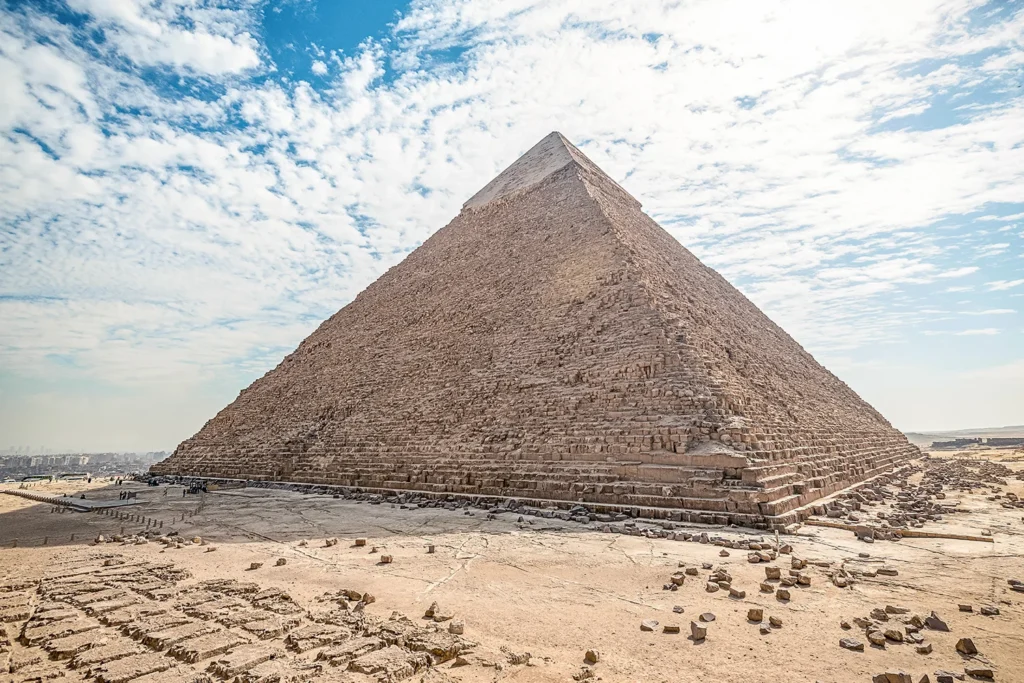
At first glance, the Pyramid of Khafre, the son of Khufu, might appear to be the same height as the Great Pyramid. In fact, in some photos, it can even look taller than its more famous counterpart on the Giza Plateau. However, this is a clever illusion. Khafre built his tomb on slightly higher ground, making it seem as tall as his father’s monument. Additionally, the second-largest pyramid is slightly steeper, further enhancing the impression of greater height. The actual difference is minimal—about 3 meters.
Unlike the Great Pyramid, the top of Khafre’s pyramid still retains some of its original polished white limestone casing stones, which were quarried from Tura. These remnants help us imagine how the pyramids might have looked when fully covered in this gleaming material. However, the true treasure of this pyramid lies underground, as it once held Khafre’s burial chamber. Unfortunately, by the time it was excavated, only a granite sarcophagus remained, as the other valuable items (including the king’s mummy) had likely been stolen centuries ago.
Pyramid of Menkaure
The third and smallest of the main pyramids is the tomb of Menkaure, Khufu’s grandson. Originally, this pyramid stood at 65 meters tall, and its base covered only a quarter of the area of its predecessors’ tombs. Several factors contributed to its smaller size. Primarily, the limited space on the Giza Plateau played a role, as did Menkaure’s decision to use granite for the lower part of the pyramid’s casing. This stone was quarried in Aswan, more than 800 km away, making the transportation of the heavy granite blocks a logistical challenge. Therefore, a smaller pyramid meant fewer transport difficulties.
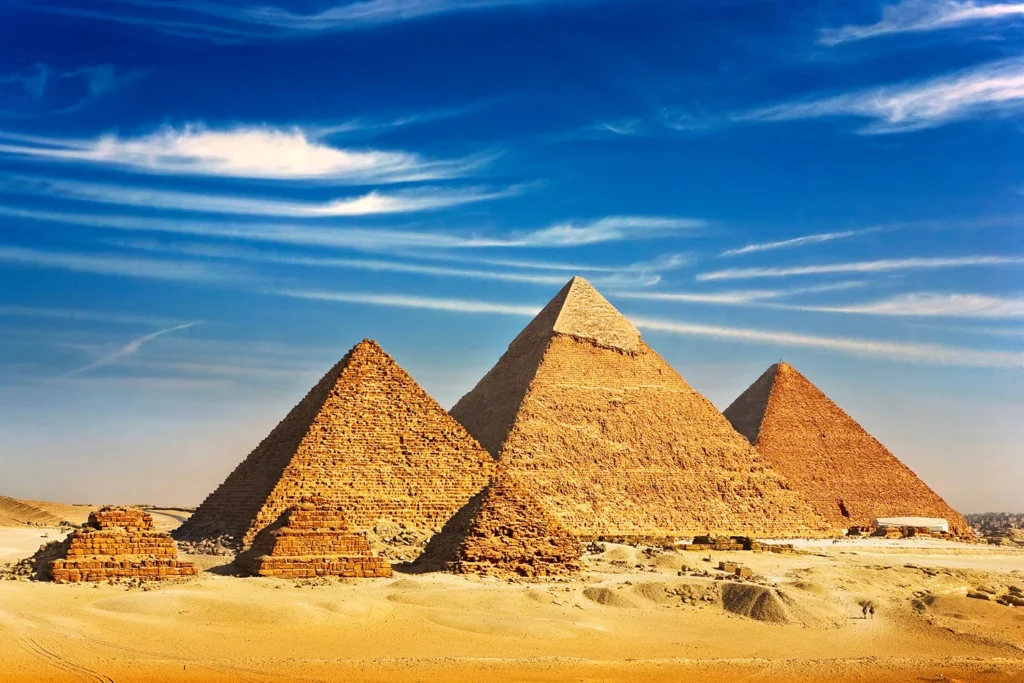
Near Menkaure’s pyramid, you can find three smaller pyramids, each about 20 meters tall. These are commonly referred to as the “Queens’ Pyramids,” implying they housed the remains of royal women. Excavations indeed confirmed that women were buried in them. However, it’s believed that one of the structures may have initially served as a cult pyramid, intended for the veneration of the pharaoh’s soul.
The Great Sphinx
It’s hard to say whether the title of the most famous ancient Egyptian structure belongs to the Great Pyramid or the ever-watchful Sphinx guarding the sandy pyramids. After all, this unique construction is unlike anything else. The Great Sphinx of Giza was carved directly from rock during the reign of the 4th Dynasty, between 2613 and 2494 BCE. The Sphinx represents a massive lion with the head of a pharaoh, likely symbolizing the immense power of the ruler.
But which ruler does it represent? Most scholars believe the head portrays Pharaoh Khafre, as the mythical creature stands beside his pyramid, and its features bear a striking resemblance to statues of Khufu’s son. However, some argue that the Sphinx may have been modeled after the goddess Isis. It’s challenging for experts to completely dismiss any theory, as numerous facial damages, including the missing nose and beard, complicate the identification of the original figure.
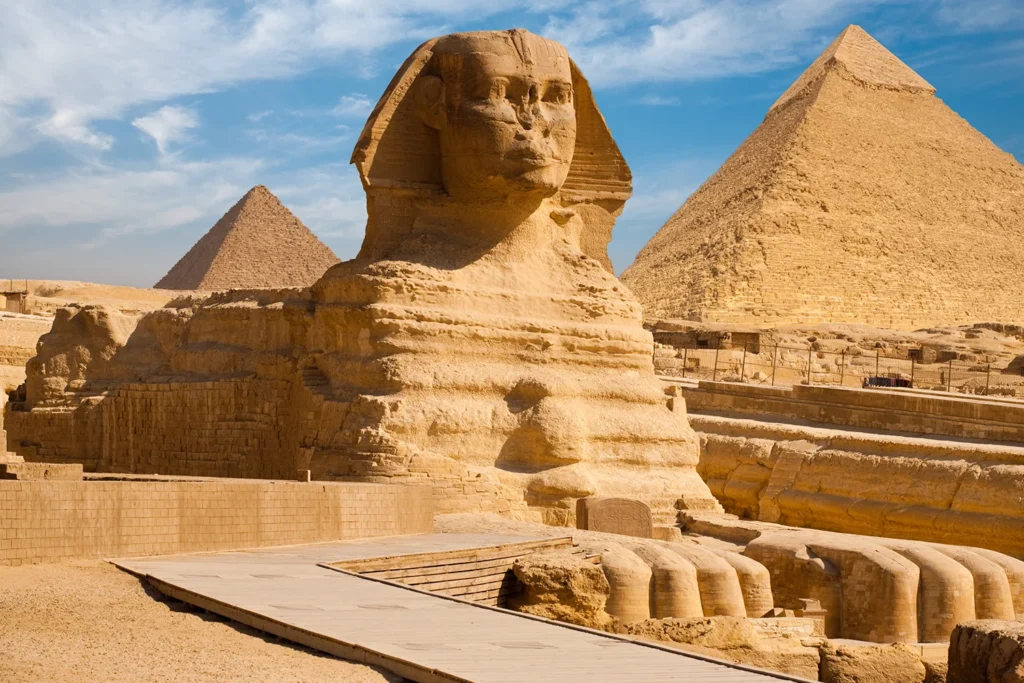
FUN FACT: In antiquity, the Sphinx was known by another name: Harmachis, meaning “Horus of the Horizon.” This name paid tribute to the sun god, often depicted in the form of a lion.
Other Structures on the Giza Plateau
As you walk among the fascinating remnants of ancient Egyptian civilization, you’ll encounter not only the pyramids and their adjoining temples but also two of the largest surviving cemeteries from the Old Kingdom of Egypt. These are located on the eastern and western sides of the Great Pyramid. To this day, many beautifully decorated tombs, called mastabas, can still be seen. Most of these were intended for the closest relatives of Pharaoh Khufu. Among them, the tomb of his mother, Queen Hetepheres I, and his half-brother were discovered. Some burial sites were also reserved for high-ranking officials, including Hemiunu, the chief overseer of the construction of the Great Pyramid.
In addition to the pyramids, many individual tombs, remnants of quarries, and the ruins of a large settlement—where workers likely lived while constructing the pyramid complexes—were also found. Within the settlement, archaeologists uncovered houses, storage areas, a modest city cemetery, three main streets, a royal administrative building, and four large barracks, which experts believe were used for communal meals.
Viewing Points
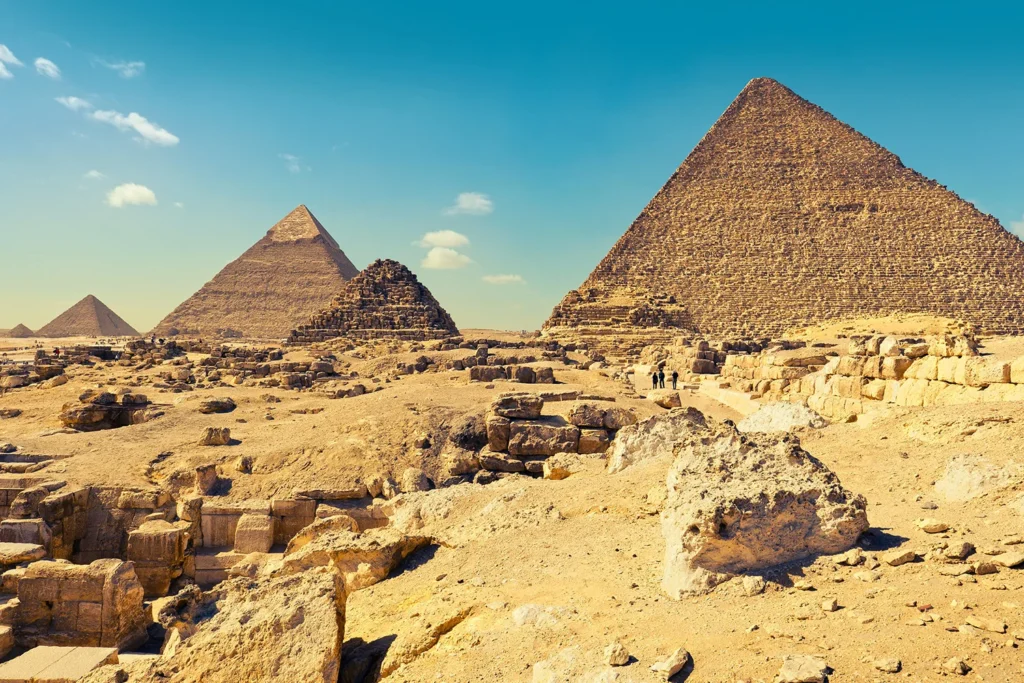
While on the Giza plateau, make sure to visit one of the designated viewing points. The most popular one offers a breathtaking view of six out of the nine pyramid structures in Giza all at once. This is also the best spot for capturing the pyramids in a wide-angle photograph.
For those who love quirky souvenir photos, there’s another viewing terrace near the Sphinx. From there, not only can you “pinch” the pyramids between your fingers, but you can also stage a “kiss” with the pharaoh-lion hybrid for a fun and memorable shot.
Visiting the Giza Complex
To explore the pyramids up close, you’ll need to purchase an entrance ticket to the plateau. If you want to enter one of the pyramids, an additional fee is required. Entry to the Great Pyramid is pricier than for the other two, and the area is usually bustling with tourists. However, the chance to walk through the Great Gallery and into the King’s Chamber is often worth the wait.
If you prefer to avoid the crowds, consider exploring the smaller tombs. You can reach the plateau from Cairo by metro, bus, or taxi, or opt for a hassle-free organized tour that typically includes transportation and a guide. You can book these tours on the GetYourGuide.
Group tours often combine a visit to the iconic pyramids with other historical Egyptian landmarks. Even if you’re planning your trip independently, consider such an option. After touring the Giza plateau, head to nearby Saqqara, where you can marvel at the Step Pyramid of Djoser or the more weathered Pyramid of Userkaf. A perfect continuation of your journey into Egypt’s past would be a visit to the Grand Egyptian Museum, which houses thousands of priceless relics from this extraordinary civilization.
Practical information
- It is worth booking tickets for Pyramids of Giza tours in advance. There are many tours available with experienced guides who will show you the most interesting spots, answer questions, and share fascinating facts about the areas being visited.
- Buy tickets on GetYourGuide